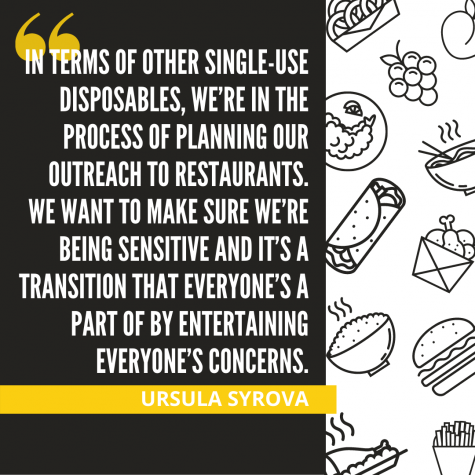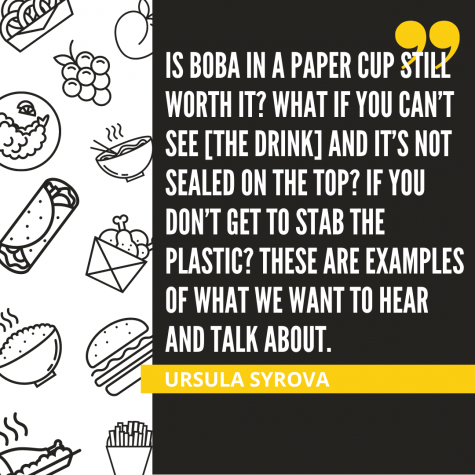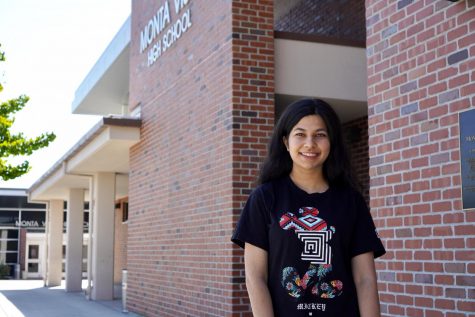Single-use plastics on the rise due to COVID-19 restrictions
Exploring steps being taken to help restaurants minimize plastic use
May 14, 2021
Over the last year with the COVID-19 pandemic, restaurants in Cupertino and all over the world have had to adjust to serving people in new ways. With the heightened need for sanitation, Cupertino High School alumnus ‘18 and City of Cupertino environmental intern Manpreet Chandok noticed an increase in plastic waste and consumption.
As part of her internship, Chandok walked around grocery stores in Cupertino and documented her observations on a spreadsheet, specifically noting the liberal use of single-use plastics. While restaurants may continue using single-use plastic bags and utensils, she mentions how important it is to say no, especially if you’re planning on taking your food home. Cupertino Environmental Programs Manager Ursula Syrova echoes a similar sentiment, stressing the importance of refusing plastic utensils and sauce packets.
“There’s still a lot of sensitivity and concerns around germs,” Syrova said. “If you’ve recently ordered takeout, you’ve probably received a pile of pouches of sauces you already have at home. We’d like for people to have to explicitly ask delivery services and restaurants for these ‘accessories.’ That is the lowest hanging fruit, but we’re in a delicate time right now so we have to focus on what we can do.”
However, she mentions how the City of Cupertino acknowledges how beleaguered restaurants are currently trying to reopen. While there are currently no specific action items for restaurants set in place by the City of Cupertino, her next steps consist of talking to the different stakeholders, including restaurant owners, employees, food rescue volunteers and organizations who help the homeless community. Once the City of Cupertino figures out its priorities, concerns and needs, Syrova hopes to help them adopt green practices by working with organizations that provide transition grants.

“[The City of Cupertino] is in the planning stage right now,” Syrova said. “The city already has the expanded polystyrene (EPS) foam ban so expanded polystyrene foam foodware is already not allowed. However, in terms of other single-use disposables, we’re in the process of planning our outreach to restaurants. We want to make sure we’re being sensitive and it’s a transition that everyone’s a part of by entertaining everyone’s concerns. Even then, it’s a phased approach. Ideally, we’re thinking about reusables for everything.”
In addition to the phased approach that will give restaurants enough time to make the necessary changes, the City of Cupertino hopes that using green business certification programs will guide businesses through the certification process and help them receive statewide recognition while refining their green practices. Sustainability manager Andre Duurvoort lists Rio Adobe as an example — as one of the first green-certified restaurants in the city, water is only provided on request. While Duurvoort acknowledges the financial strain restaurants have faced, he points to grants as a solution to extra costs like buying more silverware.
In addition to the financial strain, Duurvoort adds that COVID-19 has impacted how the City of Cupertino connects with residents and community members. The City of Cupertino had partnered with SPARKL Reusables to plan a reusable takeout container program for the in-person Earth Day event last year. People would pay extra to receive their food in rigid, plastic containers and get their money back after dropping off the container at the SPARKL booth. While they weren’t able to make it happen due to COVID-19 safety guidelines, Duurvoort mentions plans of working with SPARKL for future events. In the meantime, the City of Cupertino recently hosted its annual Earth and Arbor Day Festival virtually.
“[Plastic waste and consumption] is a topic that’s on the minds of many residents and employees in the city,” Duurvoort said. “Our focus in the city is to make sure that restaurants [and Cupertino residents] are informed about what’s coming up and enabled to respond quickly and successfully.”
As of December 2020, the City of Cupertino established a target date of 2035 for reaching a diversion rate of 90%, meaning that 90% of materials are diverted away from the landfill, and zero waste community status. Duurvoort believes that reaching a high diversion rate is challenging yet achievable by 2035 as the City of Cupertino is currently making progress towards the existing goal of 2025 for a diversion rate of 80%.
For now, Duurvoort recommends everyone, including students, ask restaurants whether they allow customers to bring reusable containers. If ordering over the phone, he adds that it doesn’t hurt to ask if they’re able to accommodate — even if they say no, the more restaurant workers hear such questions from customers, the more they’ll consider implementing such a system in the future.
“Restaurants are responsive to their customers,” Duuvoort said. “You can even start your own campaigns. If you can get 10, 20, 50, or as many as 100 students asking about reusables in one week, that is going to help the restaurant think about accommodating their customers [in that fashion].”
Syrova believes that there are many opportunities for youth to get involved, acknowledging the strong youth activist presence in Cupertino.
“When we go to the sustainability council or commission to [propose] our recommendation and ask for feedback, that’s a great time for you to show up,” Syrova said. “If you write into council as a group, it shows them that there’s a voice around that issue. They listen to that. You [can also] monitor those state bills, keep an eye on them and write to your representatives.”
Syrova believes that it’s a great time to get the conversation about plastic and single-use plastics, in particular, going. She also encourages everyone to consider what their lives would look like without the conveniences they’ve grown accustomed to.

“We would love to hear from the youth,” Syrova said. “For example, it’s important for us to know what a boba cup would look like without plastic. Is boba in a paper cup still worth it? What if you can’t see [the drink] and it’s not sealed on the top? If you don’t get to stab the plastic? What does it mean to the boba shop to change the boba container? After all, they already have the machine that seals the cellophane on top, and stabbing the plastic with the straw is part of the experience we don’t want to let go. These are examples of what we want to hear and talk about.”



























